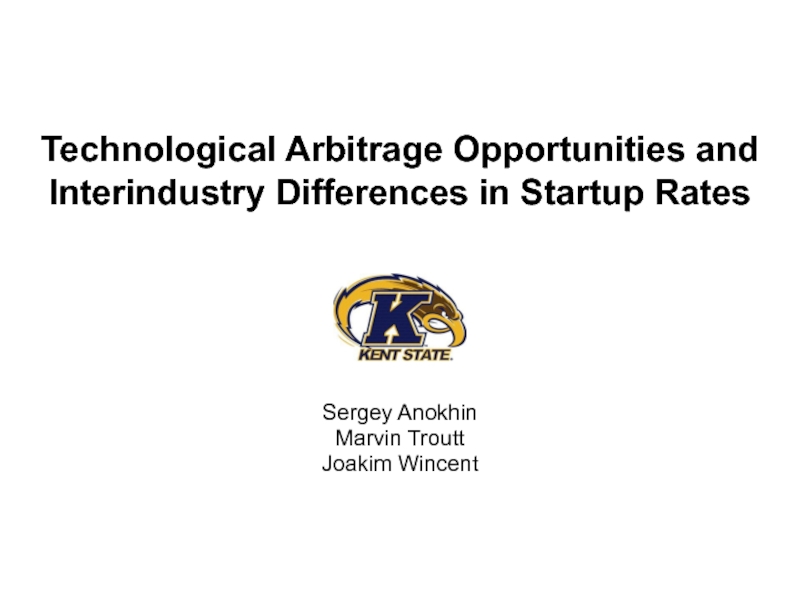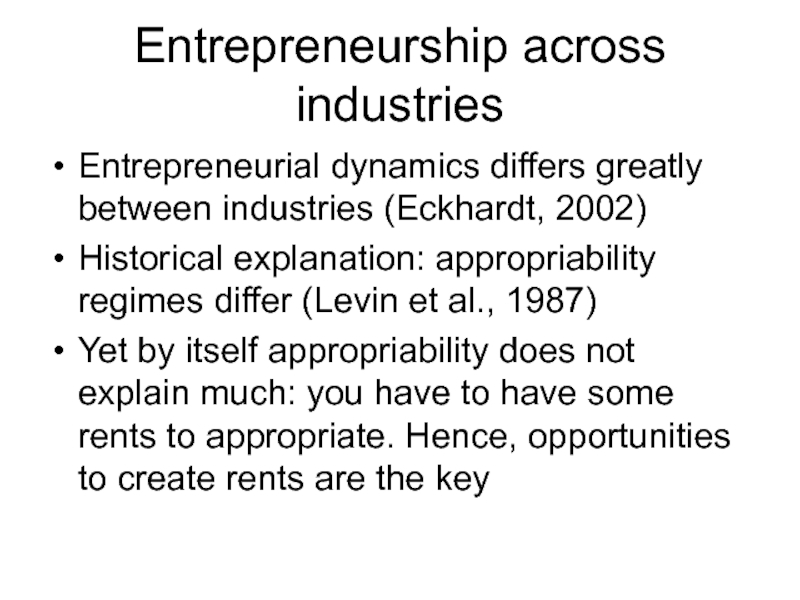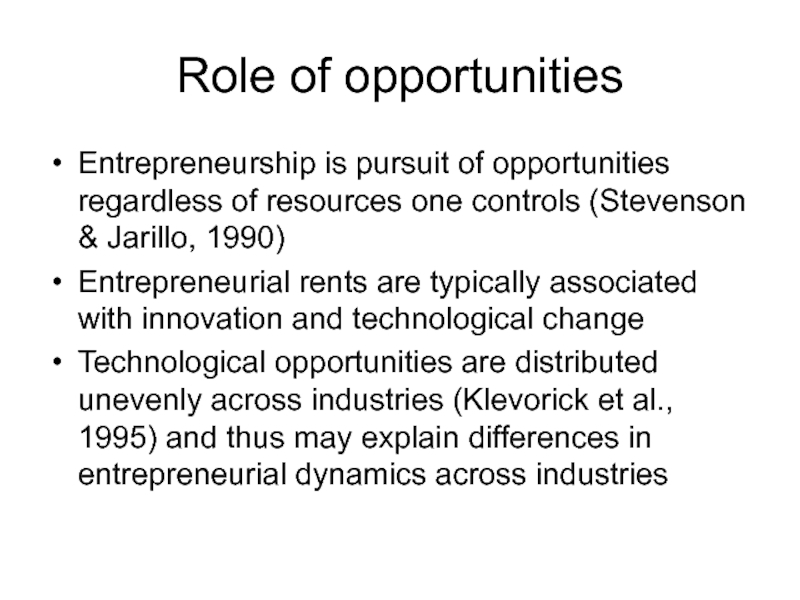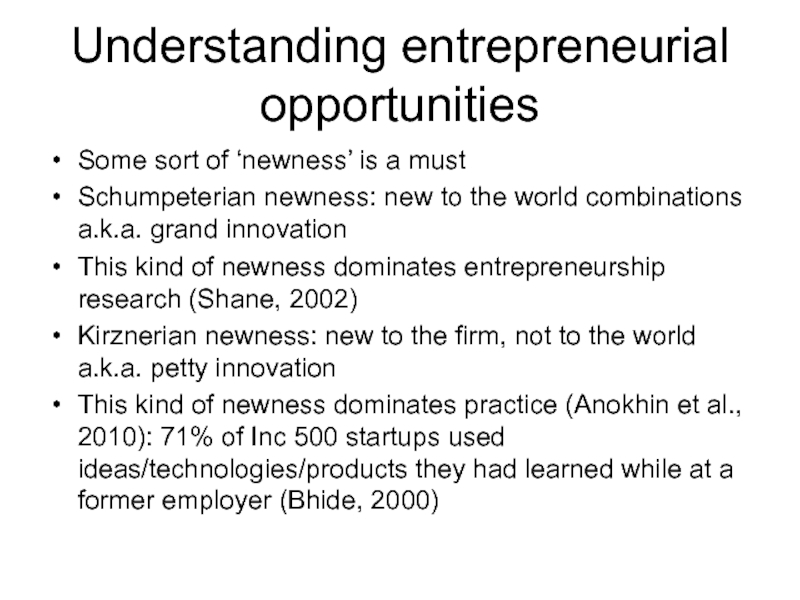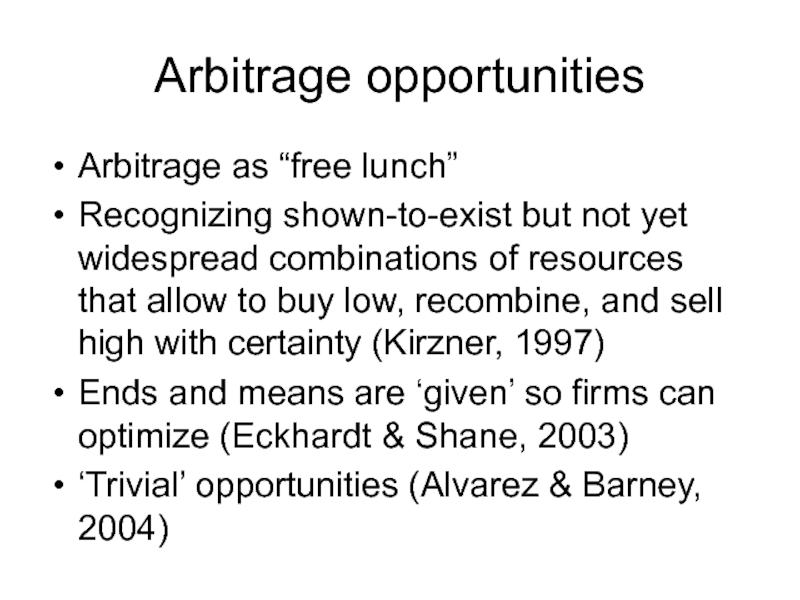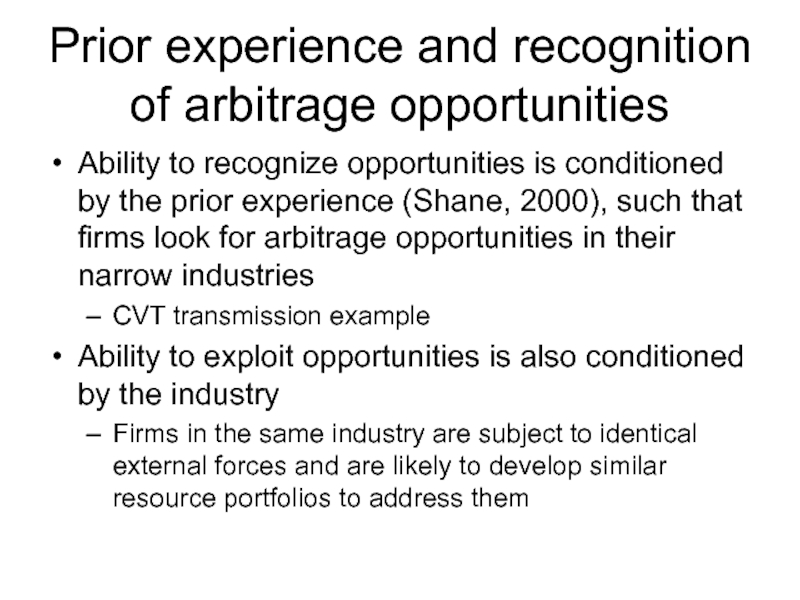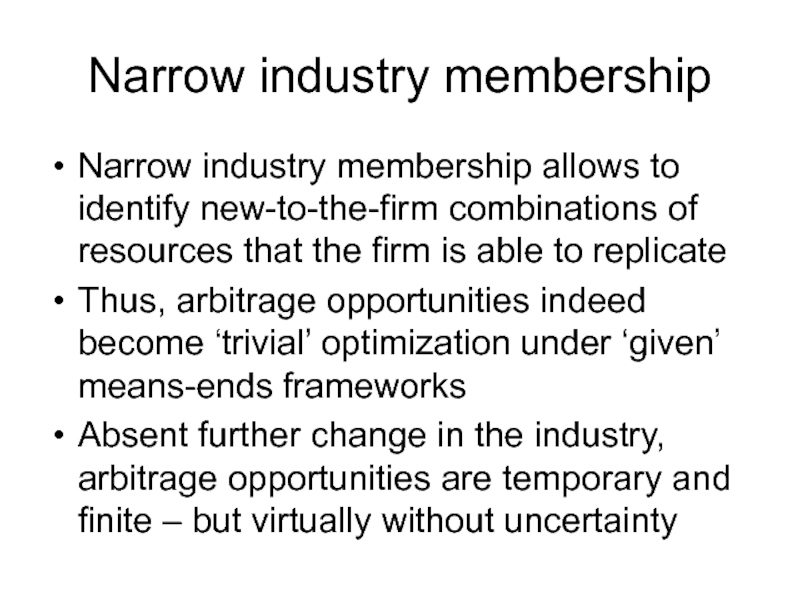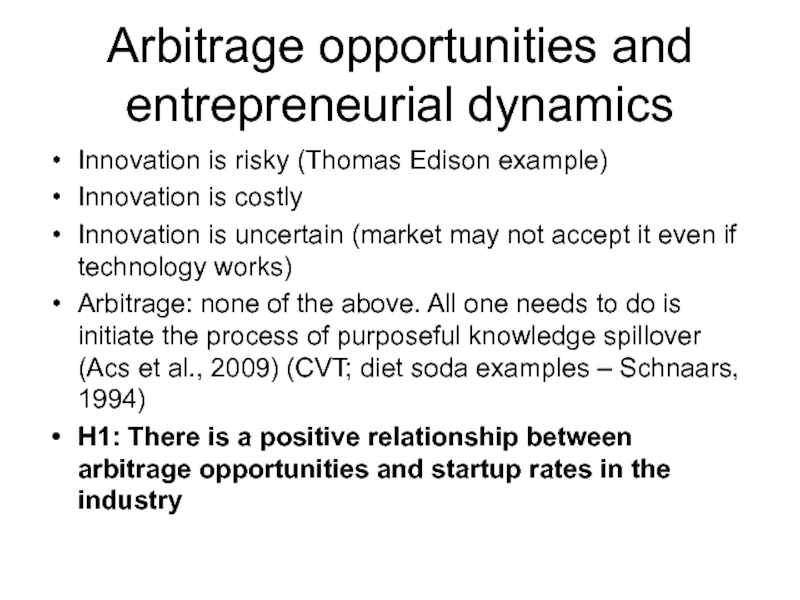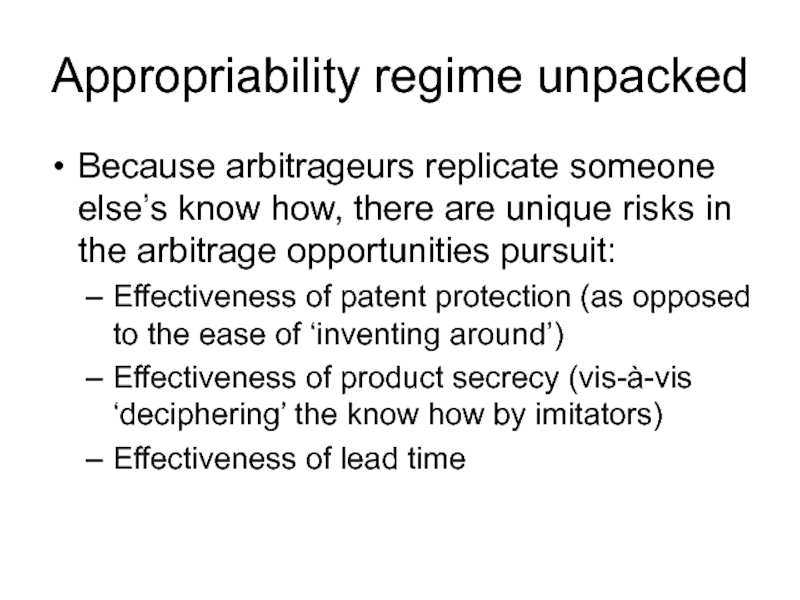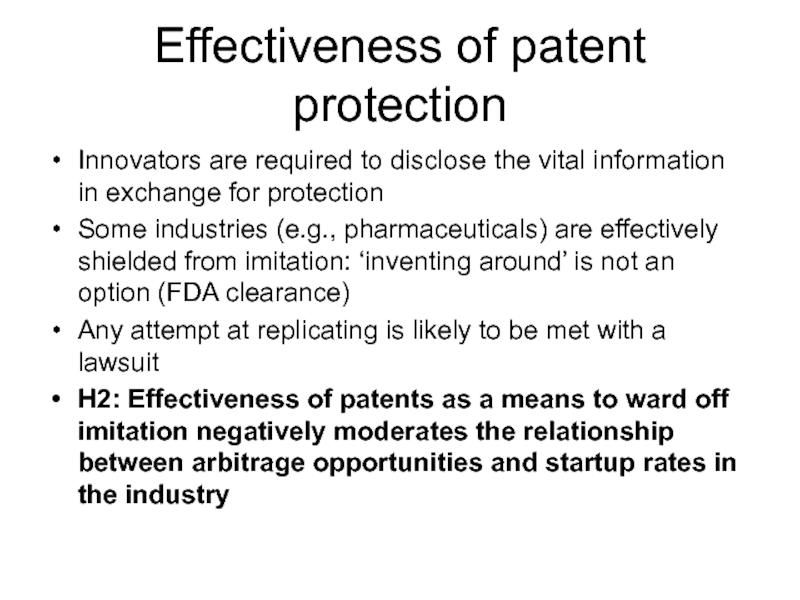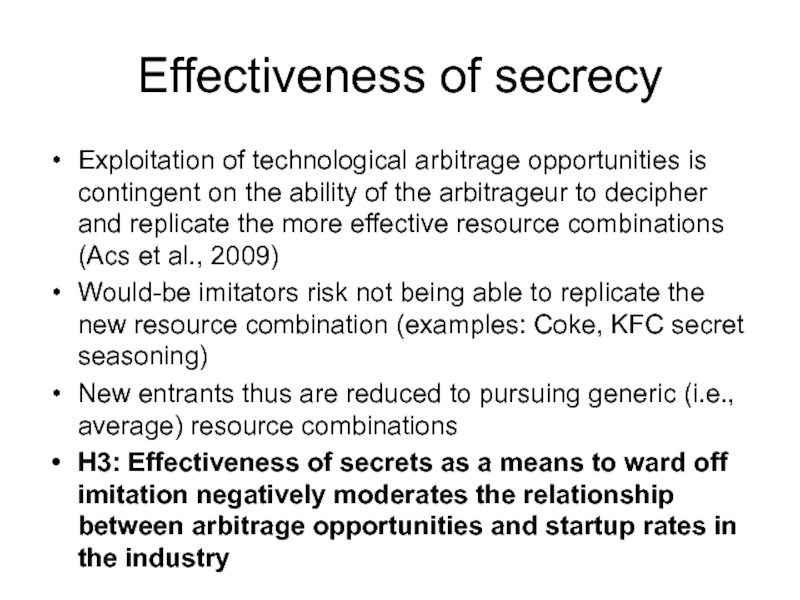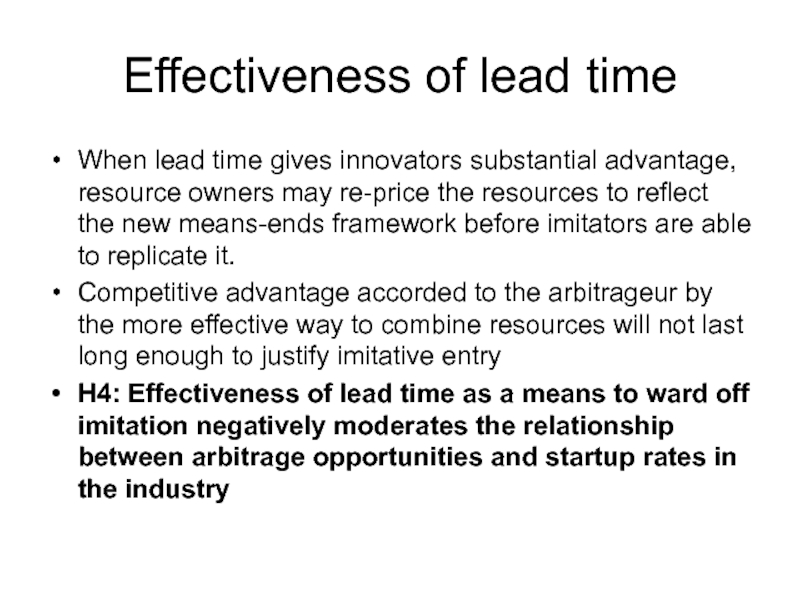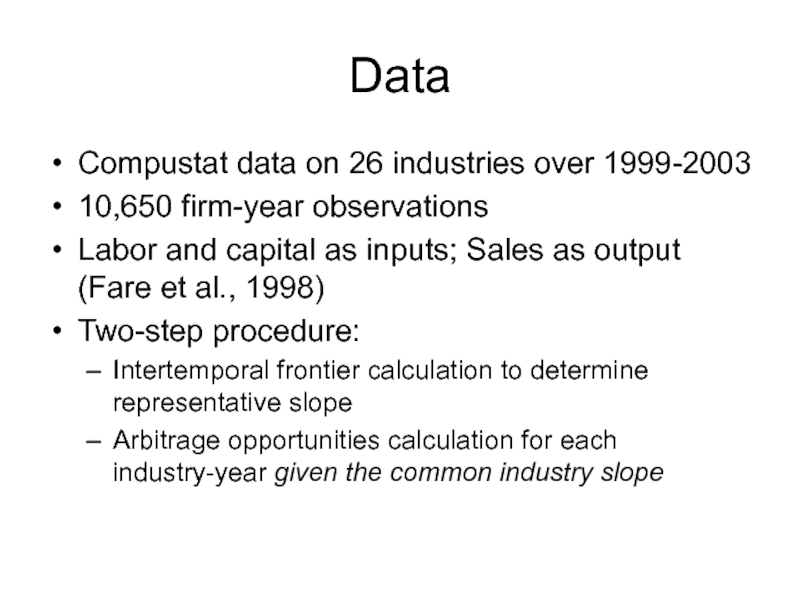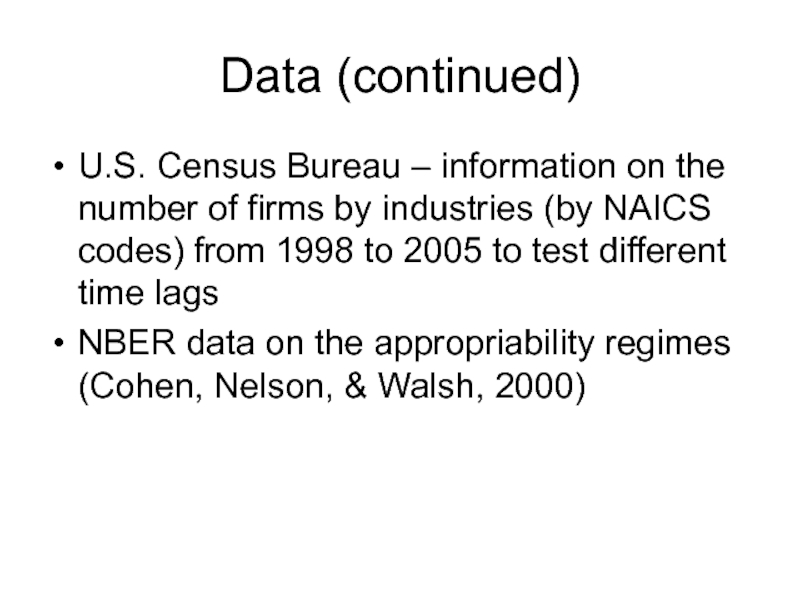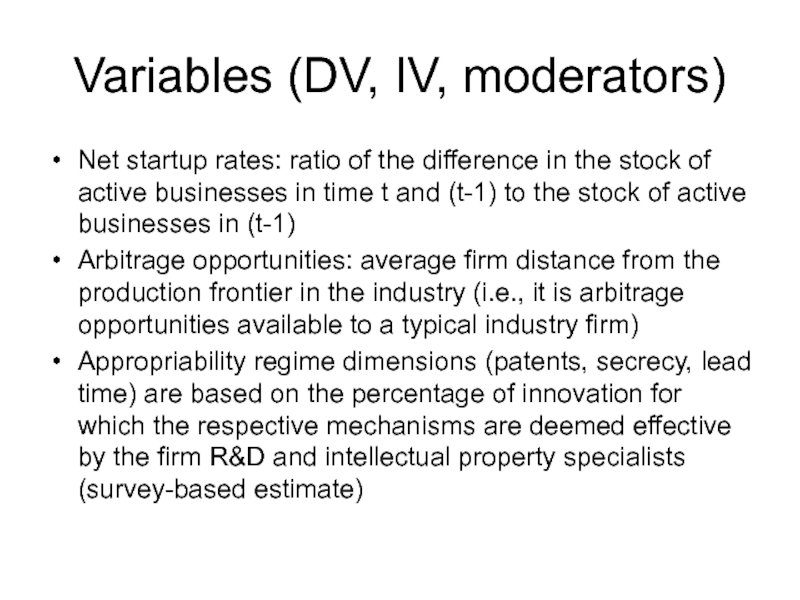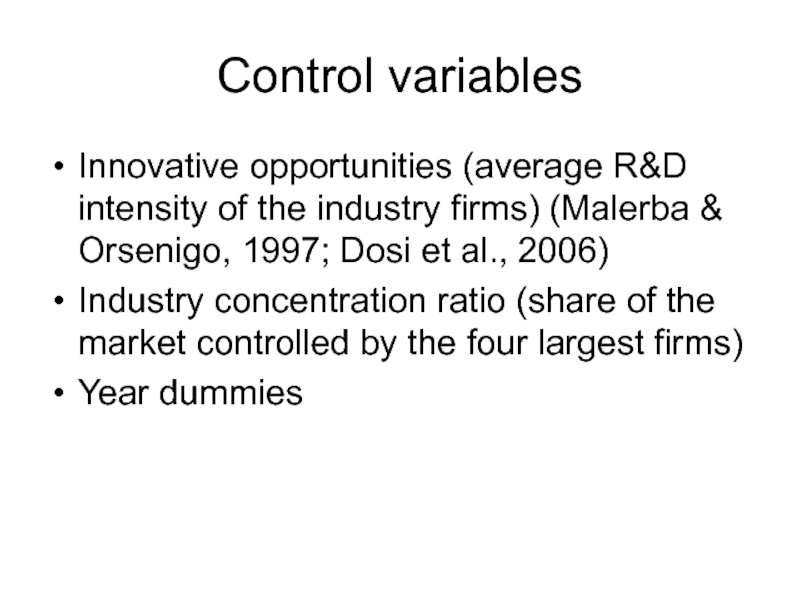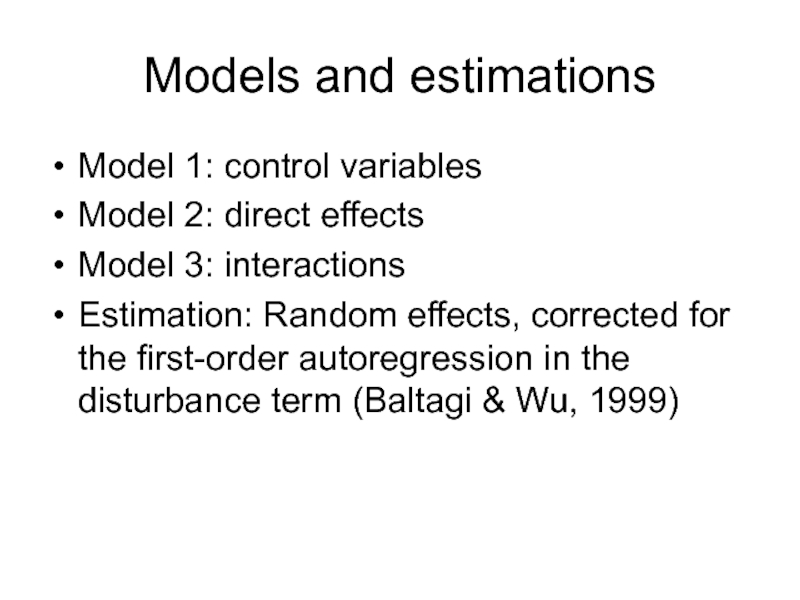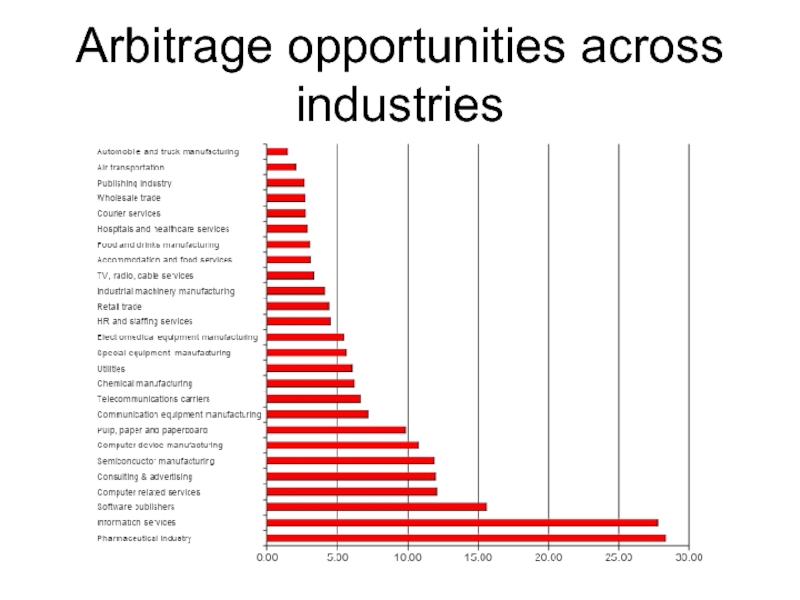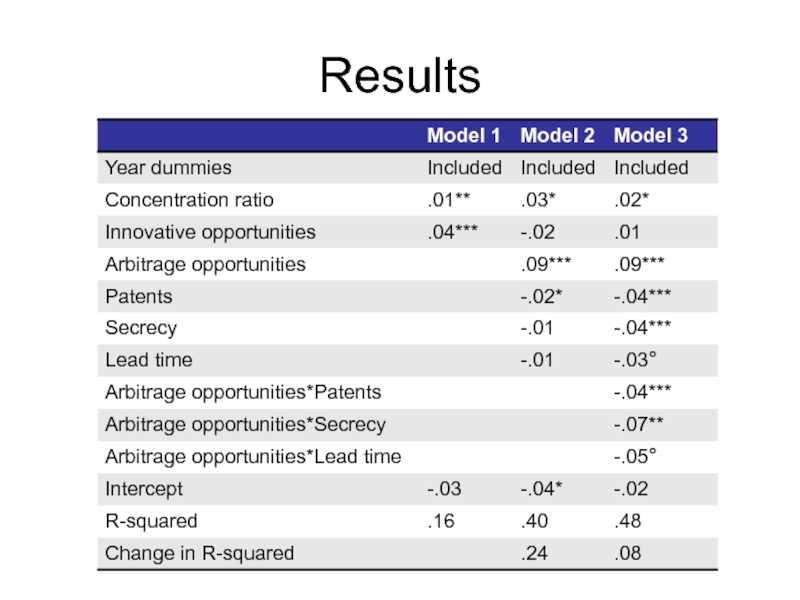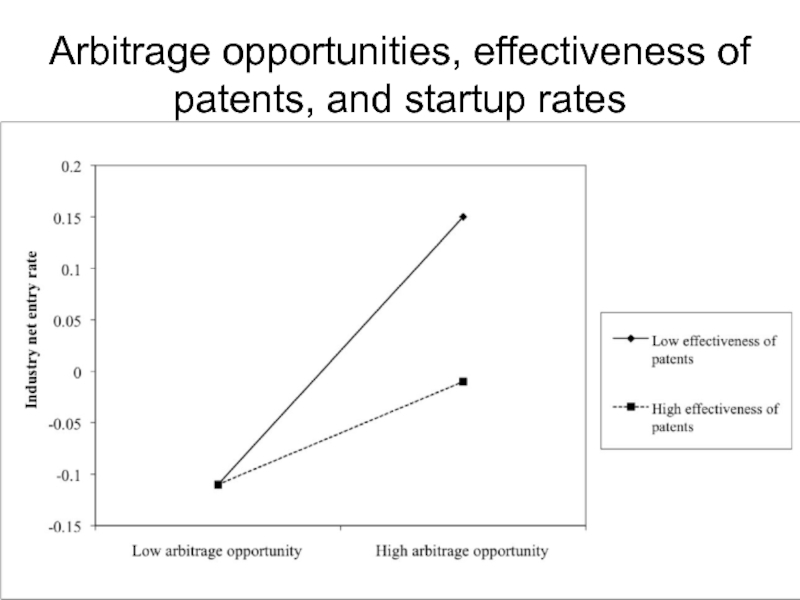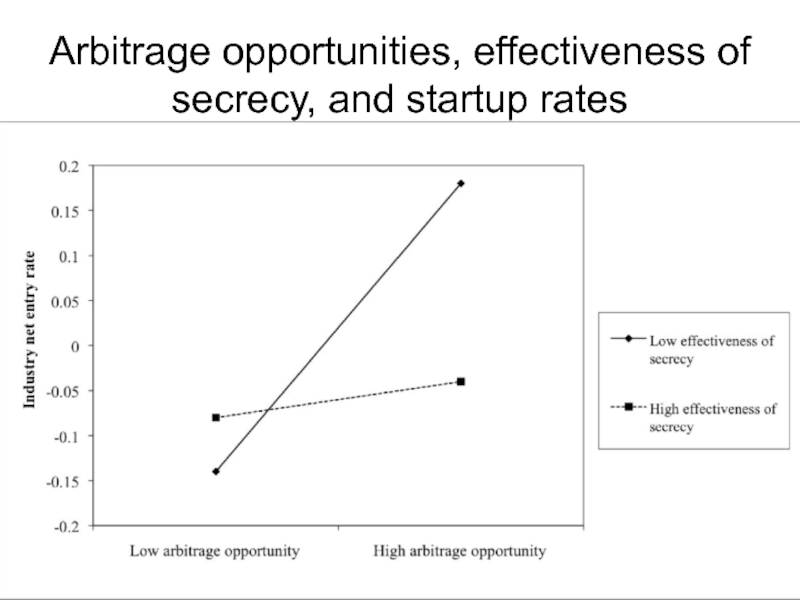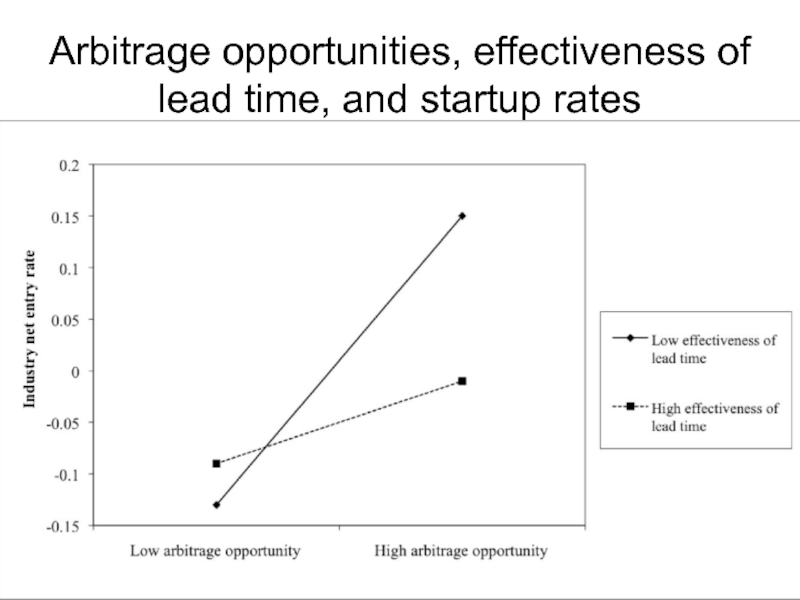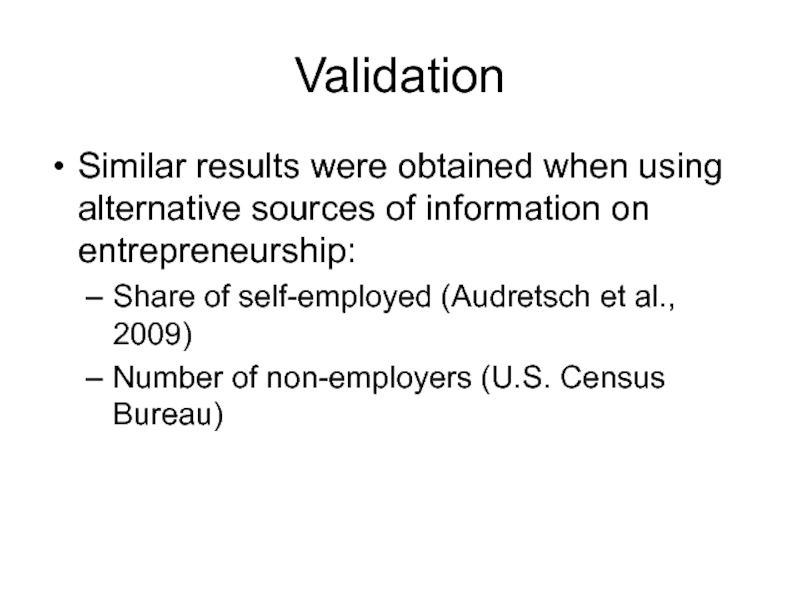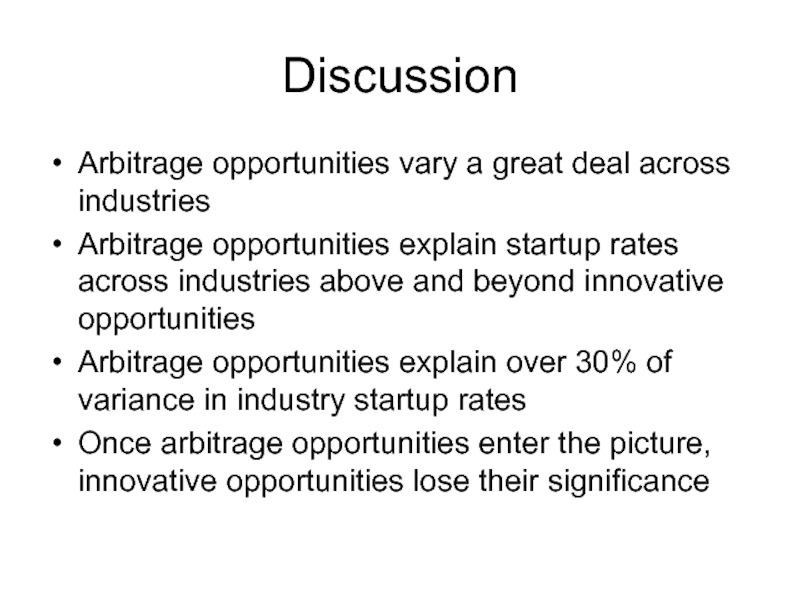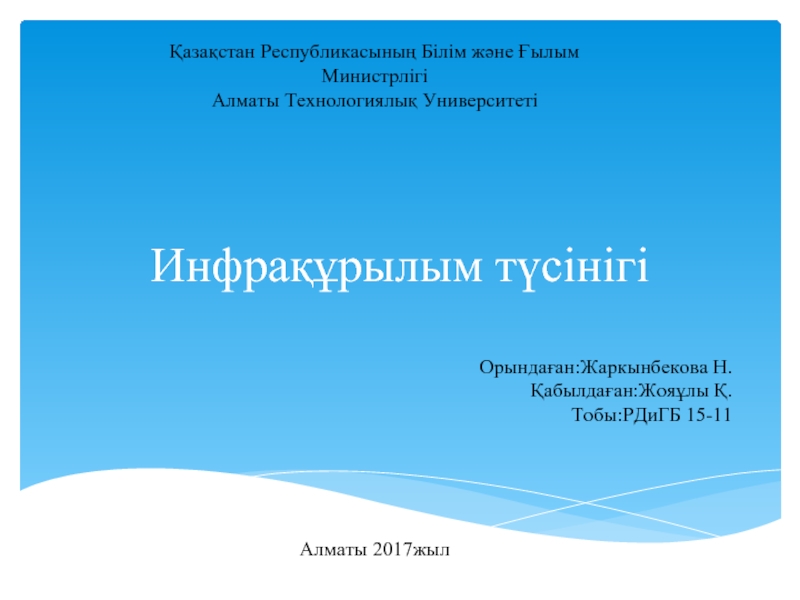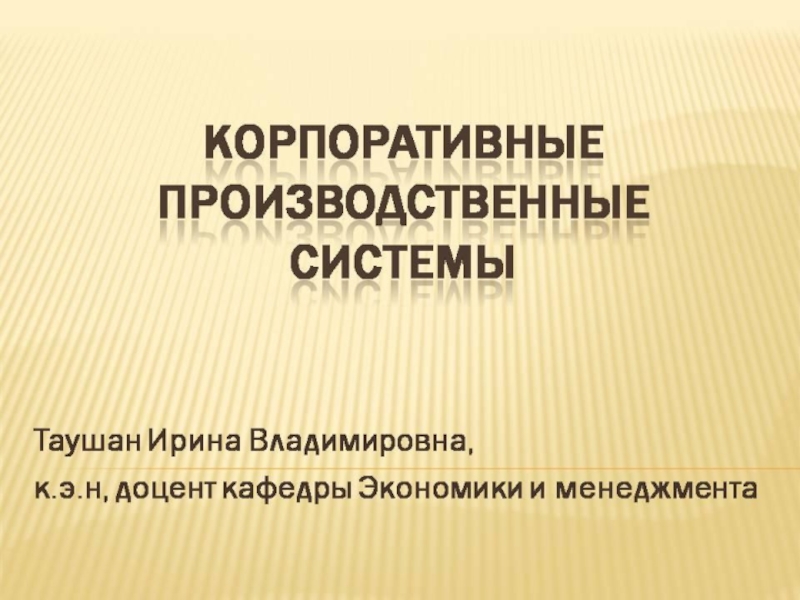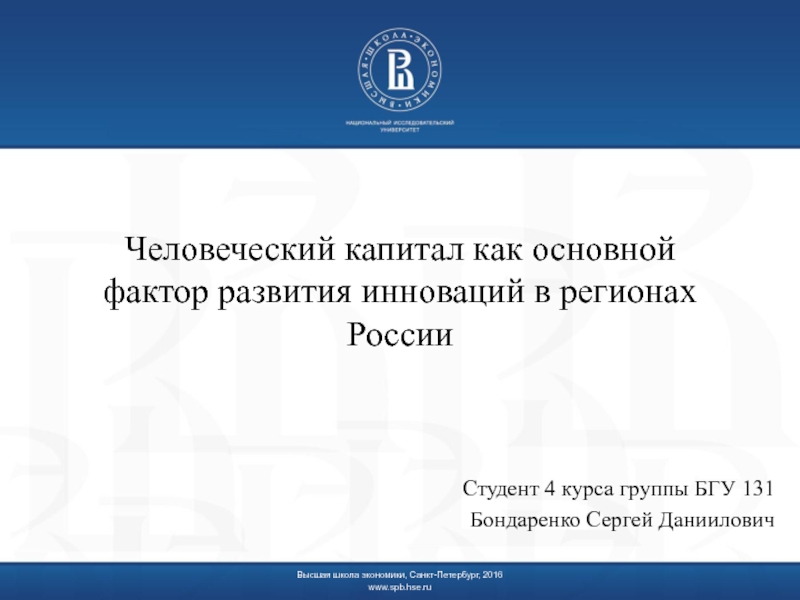Wincent
- Главная
- Разное
- Дизайн
- Бизнес и предпринимательство
- Аналитика
- Образование
- Развлечения
- Красота и здоровье
- Финансы
- Государство
- Путешествия
- Спорт
- Недвижимость
- Армия
- Графика
- Культурология
- Еда и кулинария
- Лингвистика
- Английский язык
- Астрономия
- Алгебра
- Биология
- География
- Детские презентации
- Информатика
- История
- Литература
- Маркетинг
- Математика
- Медицина
- Менеджмент
- Музыка
- МХК
- Немецкий язык
- ОБЖ
- Обществознание
- Окружающий мир
- Педагогика
- Русский язык
- Технология
- Физика
- Философия
- Химия
- Шаблоны, картинки для презентаций
- Экология
- Экономика
- Юриспруденция
Technological Arbitrage Opportunities and Interindustry Differences in Startup Rates презентация
Содержание
- 1. Technological Arbitrage Opportunities and Interindustry Differences in Startup Rates
- 2. Entrepreneurship across industries Entrepreneurial dynamics differs greatly
- 3. Role of opportunities Entrepreneurship is pursuit of
- 4. Understanding entrepreneurial opportunities Some sort of ‘newness’
- 5. Arbitrage opportunities Arbitrage as “free lunch” Recognizing
- 6. Prior experience and recognition of arbitrage opportunities
- 7. Narrow industry membership Narrow industry membership allows
- 8. Arbitrage opportunities and entrepreneurial dynamics Innovation is
- 9. Appropriability regime unpacked Because arbitrageurs replicate someone
- 10. Effectiveness of patent protection Innovators are required
- 11. Effectiveness of secrecy Exploitation of technological arbitrage
- 12. Effectiveness of lead time When lead time
- 13. Data Compustat data on 26 industries over
- 14. Data (continued) U.S. Census Bureau – information
- 15. Variables (DV, IV, moderators) Net startup rates:
- 16. Control variables Innovative opportunities (average R&D intensity
- 17. Models and estimations Model 1: control variables
- 18. Arbitrage opportunities across industries
- 19. Results
- 20. Arbitrage opportunities, effectiveness of patents, and startup rates
- 21. Arbitrage opportunities, effectiveness of secrecy, and startup rates
- 22. Arbitrage opportunities, effectiveness of lead time, and startup rates
- 23. Validation Similar results were obtained when
- 24. Discussion Arbitrage opportunities vary a great deal
- 25. Questions?
- 26. Thank you!
Слайд 1Technological Arbitrage Opportunities and Interindustry Differences in Startup Rates
Sergey Anokhin
Marvin Troutt
Joakim
Слайд 2Entrepreneurship across industries
Entrepreneurial dynamics differs greatly between industries (Eckhardt, 2002)
Historical explanation:
appropriability regimes differ (Levin et al., 1987)
Yet by itself appropriability does not explain much: you have to have some rents to appropriate. Hence, opportunities to create rents are the key
Yet by itself appropriability does not explain much: you have to have some rents to appropriate. Hence, opportunities to create rents are the key
Слайд 3Role of opportunities
Entrepreneurship is pursuit of opportunities regardless of resources one
controls (Stevenson & Jarillo, 1990)
Entrepreneurial rents are typically associated with innovation and technological change
Technological opportunities are distributed unevenly across industries (Klevorick et al., 1995) and thus may explain differences in entrepreneurial dynamics across industries
Entrepreneurial rents are typically associated with innovation and technological change
Technological opportunities are distributed unevenly across industries (Klevorick et al., 1995) and thus may explain differences in entrepreneurial dynamics across industries
Слайд 4Understanding entrepreneurial opportunities
Some sort of ‘newness’ is a must
Schumpeterian newness: new
to the world combinations a.k.a. grand innovation
This kind of newness dominates entrepreneurship research (Shane, 2002)
Kirznerian newness: new to the firm, not to the world a.k.a. petty innovation
This kind of newness dominates practice (Anokhin et al., 2010): 71% of Inc 500 startups used ideas/technologies/products they had learned while at a former employer (Bhide, 2000)
This kind of newness dominates entrepreneurship research (Shane, 2002)
Kirznerian newness: new to the firm, not to the world a.k.a. petty innovation
This kind of newness dominates practice (Anokhin et al., 2010): 71% of Inc 500 startups used ideas/technologies/products they had learned while at a former employer (Bhide, 2000)
Слайд 5Arbitrage opportunities
Arbitrage as “free lunch”
Recognizing shown-to-exist but not yet widespread combinations
of resources that allow to buy low, recombine, and sell high with certainty (Kirzner, 1997)
Ends and means are ‘given’ so firms can optimize (Eckhardt & Shane, 2003)
‘Trivial’ opportunities (Alvarez & Barney, 2004)
Ends and means are ‘given’ so firms can optimize (Eckhardt & Shane, 2003)
‘Trivial’ opportunities (Alvarez & Barney, 2004)
Слайд 6Prior experience and recognition of arbitrage opportunities
Ability to recognize opportunities is
conditioned by the prior experience (Shane, 2000), such that firms look for arbitrage opportunities in their narrow industries
CVT transmission example
Ability to exploit opportunities is also conditioned by the industry
Firms in the same industry are subject to identical external forces and are likely to develop similar resource portfolios to address them
CVT transmission example
Ability to exploit opportunities is also conditioned by the industry
Firms in the same industry are subject to identical external forces and are likely to develop similar resource portfolios to address them
Слайд 7Narrow industry membership
Narrow industry membership allows to identify new-to-the-firm combinations of
resources that the firm is able to replicate
Thus, arbitrage opportunities indeed become ‘trivial’ optimization under ‘given’ means-ends frameworks
Absent further change in the industry, arbitrage opportunities are temporary and finite – but virtually without uncertainty
Thus, arbitrage opportunities indeed become ‘trivial’ optimization under ‘given’ means-ends frameworks
Absent further change in the industry, arbitrage opportunities are temporary and finite – but virtually without uncertainty
Слайд 8Arbitrage opportunities and entrepreneurial dynamics
Innovation is risky (Thomas Edison example)
Innovation is
costly
Innovation is uncertain (market may not accept it even if technology works)
Arbitrage: none of the above. All one needs to do is initiate the process of purposeful knowledge spillover (Acs et al., 2009) (CVT; diet soda examples – Schnaars, 1994)
H1: There is a positive relationship between arbitrage opportunities and startup rates in the industry
Innovation is uncertain (market may not accept it even if technology works)
Arbitrage: none of the above. All one needs to do is initiate the process of purposeful knowledge spillover (Acs et al., 2009) (CVT; diet soda examples – Schnaars, 1994)
H1: There is a positive relationship between arbitrage opportunities and startup rates in the industry
Слайд 9Appropriability regime unpacked
Because arbitrageurs replicate someone else’s know how, there are
unique risks in the arbitrage opportunities pursuit:
Effectiveness of patent protection (as opposed to the ease of ‘inventing around’)
Effectiveness of product secrecy (vis-à-vis ‘deciphering’ the know how by imitators)
Effectiveness of lead time
Effectiveness of patent protection (as opposed to the ease of ‘inventing around’)
Effectiveness of product secrecy (vis-à-vis ‘deciphering’ the know how by imitators)
Effectiveness of lead time
Слайд 10Effectiveness of patent protection
Innovators are required to disclose the vital information
in exchange for protection
Some industries (e.g., pharmaceuticals) are effectively shielded from imitation: ‘inventing around’ is not an option (FDA clearance)
Any attempt at replicating is likely to be met with a lawsuit
H2: Effectiveness of patents as a means to ward off imitation negatively moderates the relationship between arbitrage opportunities and startup rates in the industry
Some industries (e.g., pharmaceuticals) are effectively shielded from imitation: ‘inventing around’ is not an option (FDA clearance)
Any attempt at replicating is likely to be met with a lawsuit
H2: Effectiveness of patents as a means to ward off imitation negatively moderates the relationship between arbitrage opportunities and startup rates in the industry
Слайд 11Effectiveness of secrecy
Exploitation of technological arbitrage opportunities is contingent on the
ability of the arbitrageur to decipher and replicate the more effective resource combinations (Acs et al., 2009)
Would-be imitators risk not being able to replicate the new resource combination (examples: Coke, KFC secret seasoning)
New entrants thus are reduced to pursuing generic (i.e., average) resource combinations
H3: Effectiveness of secrets as a means to ward off imitation negatively moderates the relationship between arbitrage opportunities and startup rates in the industry
Would-be imitators risk not being able to replicate the new resource combination (examples: Coke, KFC secret seasoning)
New entrants thus are reduced to pursuing generic (i.e., average) resource combinations
H3: Effectiveness of secrets as a means to ward off imitation negatively moderates the relationship between arbitrage opportunities and startup rates in the industry
Слайд 12Effectiveness of lead time
When lead time gives innovators substantial advantage, resource
owners may re-price the resources to reflect the new means-ends framework before imitators are able to replicate it.
Competitive advantage accorded to the arbitrageur by the more effective way to combine resources will not last long enough to justify imitative entry
H4: Effectiveness of lead time as a means to ward off imitation negatively moderates the relationship between arbitrage opportunities and startup rates in the industry
Competitive advantage accorded to the arbitrageur by the more effective way to combine resources will not last long enough to justify imitative entry
H4: Effectiveness of lead time as a means to ward off imitation negatively moderates the relationship between arbitrage opportunities and startup rates in the industry
Слайд 13Data
Compustat data on 26 industries over 1999-2003
10,650 firm-year observations
Labor and capital
as inputs; Sales as output (Fare et al., 1998)
Two-step procedure:
Intertemporal frontier calculation to determine representative slope
Arbitrage opportunities calculation for each industry-year given the common industry slope
Two-step procedure:
Intertemporal frontier calculation to determine representative slope
Arbitrage opportunities calculation for each industry-year given the common industry slope
Слайд 14Data (continued)
U.S. Census Bureau – information on the number of firms
by industries (by NAICS codes) from 1998 to 2005 to test different time lags
NBER data on the appropriability regimes (Cohen, Nelson, & Walsh, 2000)
NBER data on the appropriability regimes (Cohen, Nelson, & Walsh, 2000)
Слайд 15Variables (DV, IV, moderators)
Net startup rates: ratio of the difference in
the stock of active businesses in time t and (t-1) to the stock of active businesses in (t-1)
Arbitrage opportunities: average firm distance from the production frontier in the industry (i.e., it is arbitrage opportunities available to a typical industry firm)
Appropriability regime dimensions (patents, secrecy, lead time) are based on the percentage of innovation for which the respective mechanisms are deemed effective by the firm R&D and intellectual property specialists (survey-based estimate)
Arbitrage opportunities: average firm distance from the production frontier in the industry (i.e., it is arbitrage opportunities available to a typical industry firm)
Appropriability regime dimensions (patents, secrecy, lead time) are based on the percentage of innovation for which the respective mechanisms are deemed effective by the firm R&D and intellectual property specialists (survey-based estimate)
Слайд 16Control variables
Innovative opportunities (average R&D intensity of the industry firms) (Malerba
& Orsenigo, 1997; Dosi et al., 2006)
Industry concentration ratio (share of the market controlled by the four largest firms)
Year dummies
Industry concentration ratio (share of the market controlled by the four largest firms)
Year dummies
Слайд 17Models and estimations
Model 1: control variables
Model 2: direct effects
Model 3: interactions
Estimation:
Random effects, corrected for the first-order autoregression in the disturbance term (Baltagi & Wu, 1999)
Слайд 23Validation
Similar results were obtained when using alternative sources of information
on entrepreneurship:
Share of self-employed (Audretsch et al., 2009)
Number of non-employers (U.S. Census Bureau)
Share of self-employed (Audretsch et al., 2009)
Number of non-employers (U.S. Census Bureau)
Слайд 24Discussion
Arbitrage opportunities vary a great deal across industries
Arbitrage opportunities explain startup
rates across industries above and beyond innovative opportunities
Arbitrage opportunities explain over 30% of variance in industry startup rates
Once arbitrage opportunities enter the picture, innovative opportunities lose their significance
Arbitrage opportunities explain over 30% of variance in industry startup rates
Once arbitrage opportunities enter the picture, innovative opportunities lose their significance
